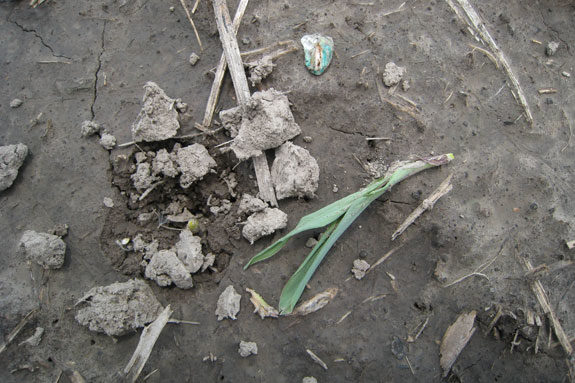"This is especially true when it comes to crop scouting," Bellm said. "When thousands of acres need to be covered in a very short time frame and the late planting date leaves little opportunity to replant a damaged, less than optimum stand, many growers tend to err on the side of caution and apply pest control measures at the earliest sign of a problem."
High commodity prices make this reaction understandable, and even hard to argue against, he said. Still, a pest management practice needs to be economical and return more dollars to the grower than what it costs to apply.
"This is where correct pest identification becomes a critical factor," Bellm said. "There are several pests of corn that can cause very similar damage symptoms, and are easily mistaken for one another if one hurries and does not observe closely."
Only one of these pests, the black cutworm, is actually manageable once the corn seed has been placed in the ground. Misidentification can lead to a pesticide application that is less than worthless. So, what are these "look-alike" problems and how are they differentiated in the field?
One type of damage currently being observed in newly emerged corn is cutting of plants at the groundline, Bellm said.
"The quick reaction is to call in the sprayers to control a black cutworm infestation," he said. "However, redwing blackbirds and grackles also cut off corn seedlings as they tug and peck in an attempt to access the seed that is buried in the ground."
Often this tugging and pecking will result in a small funnel-shaped hole in the ground at the base of the plant, a symptom not observed when the damage is caused by black cutworm.
When damage is caused by birds, the discarded seed coat will often be observed close by. Bird damage is more commonly found in fields where the habitat is conducive to blackbird nesting: adjacent to wheat fields, pastures, wetlands, and tree lines.
"An overhead power line makes an excellent staging area for birds to rest on," he said. "An observant crop scout can actually hear and observe birds entering and leaving the field in these types of areas."
A second type of look-alike damage can occur when corn reaches the V-3 to V-5 growth stage. "Dead heart" or "dead whorl" can occur when a corn plant is too large, or a black cutworm is too small to actually cut it off below ground.

In this instance, the cutworm will often wrap itself around the corn plant and create a feeding hole until it consumes the underground growing point of the plant, he said.
The plant remains upright but the whorl quickly wilts and deteriorates. The look-alike pest in this instance is often wireworm, which will also tunnel into the base of the plant and destroy the growing point.
Commonly, both pests can be found in the same field at the same time. Unfortunately, there is no rescue treatment for wireworm infestations, so if wireworm and not black cutworm is the culprit, a pesticide application is useless, Bellm said.
"The most obvious method of differentiating between these two pests is to dig up the plant and find the offending larvae," he said.
"They aren't always polite enough to stick around at the scene of the crime, so a back-up diagnostic key is to observe the size of the hole bored into the base of the plant. Wireworm tunnels are normally no more than a couple of millimeters in diameter, while a cutworm tunnel will be up to five millimeters in diameter."
For more information, read the May 26 edition of The Bulletin at http://bulletin.ipm.illinois.edu/. FG
—Excerpts from University of Illinois College of Agricultural, Consumer and Environmental Sciences ACES News website
Jennifer Shike
Media Communications Specialist
University of Illinois
jshike@illinois.edu
PHOTOS
TOP: Blackbird damage on seedling corn. Note funnel-shaped hole around base of cut plant, and discarded seed coat.
MIDDLE: Black cutworm larva can often be found at base of damaged plant. Note the lack of funnel-shaped hole, differentiating this from blackbird damage.
BOTTOM: Wireworm feeding injury. Note small diameter hole in base of plant. Photos courtesy of University of Illinois.








